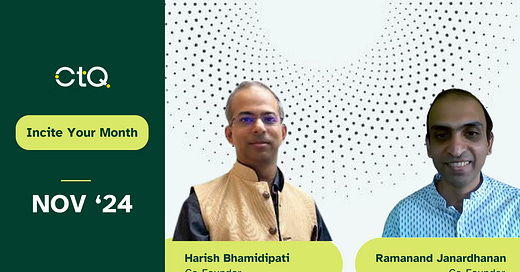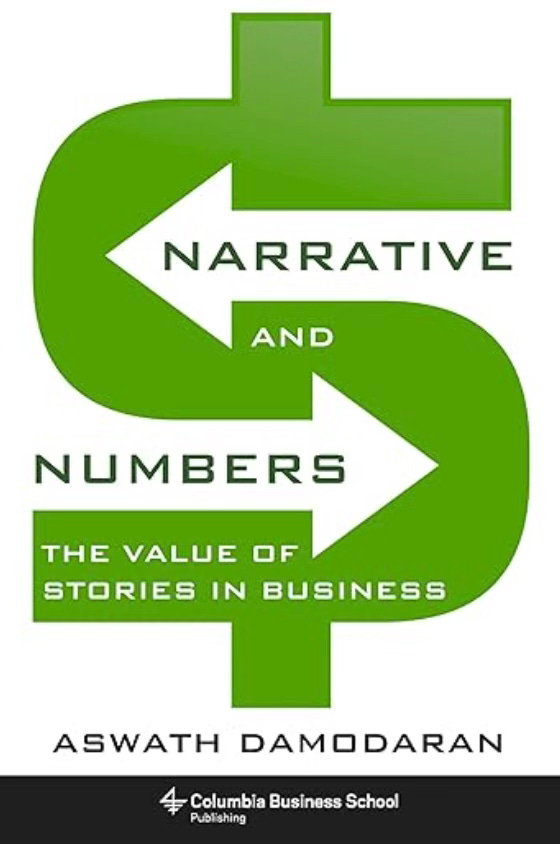Dear Uplevelers,
HAPPY DIWALI! As you enjoy the long weekend, it’s the first Friday of the month - so, it’s time for your go-to monthly collection of recommendations from our "Curiosity Diet", where we delve into a curated selection of recommendations for uplevelers and decision-makers that have piqued our curiosity and passion for thought.
Today we explore the fascinating intersection of data and storytelling, examine innovative decision-making frameworks, and uncover how businesses can navigate transformative waves of change. Btw, if you are more of a visual person, you can watch this 13-minute episode on YouTube. But without further ado:
📚 Book of the Month: “Narratives and Numbers”
To start with, the author, Aswath Damodaran, is renowned as the ultimate "numbers guy" in business valuations. In a surprising take, though, he makes a compelling case for the power of storytelling in business valuations. This revelation feels particularly poignant coming from someone whose career has been built on hard data and mathematical models.
The book's central thesis challenges the false dichotomy between quantitative and qualitative analysis. Through various business narratives—from ‘bully stories’ to ‘missionary stories’, Aswath demonstrates how compelling narratives can bridge the gap between raw numbers and market perception.
This insight resonates deeply with our own journey at Choose to Thinq, where we've increasingly recognized that the most impactful business insights often emerge at the intersection of data and narrative.
The author's candid admission about missing significant investment opportunities due to an overly numerical focus serves as a powerful reminder: even the most sophisticated quantitative analysis can fall short without the context that stories provide.
Key Takeaway: In today's complex business environment, the ability to weave compelling narratives around numerical insights isn't just a nice-to-have skill—it's a crucial competency for business leaders, analysts, and decision-makers.
💡 Leadership Insight: Coinbase's Written Culture

Emily Choi, President and COO of Coinbase, offers a fascinating glimpse into how one of the world's leading cryptocurrency exchanges approaches decision-making through what they call a "written culture." This approach particularly caught our attention because it aligns with our own evolution towards more documented, thoughtful communication. The cornerstone of the decision-making framework is the RAPID system:
Recommend
Agree
Perform
Input
Decide
What makes this system particularly effective is its emphasis on clear accountability while ensuring comprehensive input. Despite involving multiple stakeholders, each decision has a single owner—a approach that combines inclusive discussion with decisive action.
The written culture serves several crucial functions:
Creates a clear record of decision-making processes
Ensures all stakeholders' views are documented and considered
Reduces the need for repetitive meetings
Provides a reference point for future decisions
Facilitates asynchronous collaboration across time zones
Practical Implementation: Consider implementing a similar documentation-first approach in your organization, starting with major cross-functional decisions. Create templates that capture:
The decision to be made
Stakeholders involved and their roles
Key considerations and constraints
Alternative options considered
Final decision and rationale
🌊 Deep Dive: Navigating Business Rogue Waves
Jonathan Brill's "Rogue Waves" presents a compelling metaphor for understanding disruptive change in business. Just as multiple waves in the ocean can combine to create massive, unpredictable rogue waves, various trends and forces in the business world can converge to create industry-transforming events.
One of the most striking insights from the book is Amazon's approach to risk management. The company employs more economists than any other private entity, using their expertise to model and prepare for various risk scenarios. This investment in forward-thinking paid dividends during the pandemic, when Amazon's preparedness allowed them to adapt more quickly than many competitors.
Perhaps the most practical insight from the book is what we're calling "The Kayak Principle." In turbulent waters, smaller, more agile vessels (kayaks) often fare better than larger ships. They can:
Adapt quickly to changing conditions
Recover faster from setbacks
Navigate through tight spots
Maintain momentum with minimal resource investment
This principle applies equally well to business:
Small teams can pivot more quickly
Lean organizations can adapt to market changes
Recovery from failure can be faster and less costly
Resources can be deployed more efficiently
Strategic Implications:
Invest in trend monitoring and scenario planning
Build organizational agility through smaller, autonomous teams
Develop quick recovery protocols for when disruption hits
Maintain sufficient resources for rapid adaptation
Create a culture that embraces change and uncertainty
🎙️ Curiosity Corner: Insights from Walter Isaacson
The Knowledge Project's interview with Walter Isaacson, renowned biographer of innovators like Steve Jobs offers fascinating insights into the relationship between curiosity and creativity. What makes this particularly relevant is how it connects to both personal development and organizational innovation.
Through his extensive study of remarkable individuals, Isaacson identifies several common patterns:
Deep Curiosity: Going beyond surface-level questions to explore fundamental principles
Cross-Disciplinary Thinking: Finding connections across seemingly unrelated fields
Persistent Questioning: Maintaining childlike wonder about everyday phenomena
Active Observation: Taking detailed notes and making careful observations
Practical Application: Converting curiosity into tangible innovations or insights
One fascinating parallel Isaacson draws is between Einstein and da Vinci's shared curiosity about “Why the sky is blue” This seemingly simple question appears in both their notebooks, demonstrating how fundamental curiosity transcends time and discipline.
Personal Development Action Items:
Keep a curiosity journal
Ask "why" questions about everyday phenomena
Explore connections between different fields of interest
Document observations and insights
Seek practical applications for your discoveries
Btw, do check out our latest FutureStack for AI ebook. Here we curate 30 pieces to give you insights into what the future may look like. It’s ideal for professionals and leaders to stay ahead of the curve. Pick an article, read & reflect!
🏏 SmartCast: Data Transformation in Cricket
Our SmartCast monthly pick was the one with Sumeet Pai, which was about the Indian cricket team's data transformation journey. This offers valuable lessons about implementing change in traditional environments. There are key success factors which can be used in your own line of work:
Building Trust Through Service
Started with basic technical support (setting up email accounts)
Helped with practical training needs (throwing practice)
Built personal relationships before pushing analytical tools
Leveraging Corporate Skills
Applied business presentation skills to sports analysis
Brought structured thinking to performance analysis
Bridged the gap between technical data and practical application
Managing Cultural Change
Worked with both traditional cricket wisdom and modern analytics
Built bridges between different generational approaches
Created buy-in through demonstrated value
Technical Implementation
Introduced data-driven decision making gradually
Created user-friendly analytical tools
Integrated technology without disrupting existing processes
💡 Productivity Tip of the Month: Newsletter Management
As the digital content landscape continues to expand, managing the flood of newsletters has become increasingly challenging. Here's our tested solution for maintaining information flow without drowning in it:
Create a Separate Email Account
Use it exclusively for newsletter subscriptions
Keep your primary inbox focused on direct communication
Reduce the psychological burden of "unread" counts
Implementation Steps:
Create a new email account for newsletters
Update existing newsletter subscriptions
Set up filters in your main email to forward newsletters
Schedule specific times for newsletter reading
Reading Strategy:
Treat it like a content feed rather than an inbox
Set aside dedicated reading times
Use the "inbox zero" approach less strictly
Focus on extracting value rather than completing everything
We'd love to hear your thoughts on these topics and how you're applying these insights in your own work and life!
We hope you liked this week’s newsletter and if you wish to uplevel
Yourself: Watch our YouTube Playlist & join CTQ Compounds.
Your Team: See our Case Studies & connect with us








